A runny nose is accompanied by the appearance of not only local symptoms, but general symptoms. Lack of nasal breathing makes communication difficult, reduces performance and interferes with sleep. As a result, a person becomes irritable and inadequately responds to environmental factors. Today, vasoconstrictor nasal drops are widely used. They quickly facilitate breathing through the nose and retain the healing effect for up to 12 hours.
- the active substance of the drug is absorbed into the mucous membrane, penetrates into the blood vessels;
- the drug interacts with the adrenergic receptors of the vascular wall;
- vasospasm is observed, that is, the diameter of the vessels decreases;
- swelling of tissues decreases;
- the volume of mucous secretions decreases;
- nasal congestion is eliminated;
- the degree of tissue hyperemia decreases;
- the patency of the nasal passages for air is restored;
- easier nasal breathing.
Preparations for the common cold can be produced in the form of a solution for drip administration or in the form of an aerosol. All drugs are based on active substances such as phenylephrine, xylometazoline, tramazoline, oxymetazoline, naphazoline.
Phenylephrine medications
In medical practice, phenylephrine is used for systemic action (increasing blood pressure), as well as topically. To combat nasal congestion, solutions of 0.25-0.5% are usually used. They are quite effective, allowed for use in childhood... The duration of the therapeutic effect lasts up to 3-4 hours.
This group of drugs includes Vibrocil, Nazol baby, Rinza, Adrianol, Polidexa.
Vibrocil
The drug is widely used in otolaryngology, including in childhood. It does not disrupt the functioning of the cilia of the epithelium, does not irritate the mucous membrane. It also contains an antihistamine component, which makes it possible to prescribe it for allergic rhinitis.
Vibrocil is instilled into the nose with otitis media to reduce tissue swelling and restore ventilation in the ear cavities. Apply 2-4 drops up to 4 times a day.
Among the contraindications, it is worth highlighting:
- atrophic type of rhinitis;
- taking antidepressants;
- age up to 2 years;
- glaucoma.
Caution must be observed in the treatment of people with severe hypertension, epilepsy, diabetes mellitus, prostate hypertrophy and hyperfunction of the thyroid gland. Exceeding the recommended doses increases the risk of tremors, insomnia, increased blood pressure and cardiac arrhythmias.
Nazol baby
Nasal drops are prescribed for children under six years of age. The solution should be dripped 1-2 drops three times a day. The medicine acts quickly, the effect occurs 3 minutes after the instillation of the nasal passages. Thanks to glycerin, which is part of the solution, a moisturizing effect is provided. Nazol baby does not irritate the mucous membranes, therefore it rarely causes local side reactions.
Contraindications include:
- individual sensitivity to components;
- diabetes;
- thyrotoxicosis.
Among the side reactions, burning sensations, dryness in the nasopharynx, nausea, hyperemia of the skin of the face and dizziness should be distinguished.
Polydexa
In treatment bacterial rhinitis combination medications can be used, such as Polydex. Its vasoconstrictor properties are due to the presence of phenylephrine. In addition, the composition includes a hormonal substance (dexamethasone), due to which the severity of inflammation and tissue edema decreases.
Antimicrobial action is provided by polymyxin B, neomycin, which sanitize the infectious focus. For a common cold, the use of Polydex spray is not recommended, since there is no need to fight germs.
With the abuse of antimicrobial drugs for nasal administration, the composition of the flora of the nasopharynx may change.
The drug is available in the form of an aerosol. Contraindications include:
- hypersensitivity to components;
- subcompensated renal insufficiency;
- glaucoma;
- the active phase of a viral disease;
- age up to 15 years.
The spray should be used with caution in angina pectoris, thyrotoxicosis, severe hypertension, cardiac rhythm disturbances. It is important for athletes to know that a drug can test positive for doping.
Side effects include sneezing, skin rashes and burning sensations.
To date, vasoconstrictor nasal drops based on oxymetazoline are the most in demand. Their effect lasts up to 12 hours after the instillation of the nasal passages.
Vasoconstrictor drugs of this group are often prescribed to children. Depending on the concentration of the active substance, there are restrictions on the age of the child. A solution of 0.025% is prescribed until the age of six, and with a concentration of 0.05% - at an older age.
Among the popular drugs, we highlight Nazol, Nesopin, Afrin, Fazin, Knoxprey. Names drugs may be different, but they are united by one active ingredient - oxymetazoline.
When administered intranasally, the drops have a decongestant effect, reduce rhinorrhea and restore the patency of the nasal passages for air.
Among the indications for the appointment of oxymetazoline, it is worth highlighting:
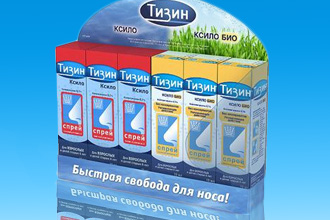
Contraindications include individual intolerance to the components of the medicinal solution, atrophic type of rhinitis. Adverse reactions are quite rare, but you need to remember about them. After instillation of the nasal passages, temporary dryness, burning, itching sensations in the nasopharynx area, as well as frequent sneezing, may occur. These symptoms go away on their own and do not require intervention.
Let's take a closer look at Nazivin.
In the case of an allergy to oxymetazoline, congestion, rhinorrhea, skin rash, facial flushing and cough may appear.
A vasoconstrictor drug can be prescribed for infants. Its effect develops after 2 minutes, after which it lasts for 10 hours, so it is advisable to bury the nasal passages before bedtime.
The solution should be used in a few drops (depending on age) twice a day. Among the contraindications, attention should be focused on:
- individual intolerance to the components of the solution;
- severe violations of the cardiac rhythm;
- hyperfunction of the thyroid gland;
- renal insufficiency;
- hepatitis;
- glaucoma;
- uncontrolled hypertension;
- atrophic type of rhinitis.
Nazivin comes in the form of a spray and solution for drip use.
Ximetazoline preparations
The main active ingredient is ximetazoline, which ensures the preservation of vasospasm for 6-8 hours. The drugs are widely used for adults with allergic, vasomotor, infectious rhinitis. Often, patients choose a spray because it is more convenient to use.
List of medicines with ximetazoline:
A medicinal solution with a concentration of 0.05% can be used at one year of age. As for the 0.1% concentration, the spray is recommended to be prescribed from the age of six.
Xilen
The drug has an effect of medium duration (up to 8 hours). The solution is available in different concentrations. Suction drug in the general bloodstream is practically not observed, therefore, systemic reactions occur only with an overdose.
Among the contraindications should be highlighted:
- individual intolerance to the components of the drug;
- severe atherosclerotic vascular disease;
- uncontrolled hypertension;
- atrophic changes in the mucous membrane;
- glaucoma;
- violation of the cardiac rhythm.
Also, restrictions in use apply to people with diabetes mellitus, angina pectoris, prostate hypertrophy, thyrotoxicosis. Nasal drops can be used two or three times a day.
If the recommended doses are exceeded, sneezing, dry mucous membranes, soreness in the nasal passages may occur. Long-term use of a vasoconstrictor drug may be accompanied by insomnia, visual dysfunction, cardiac rhythm disturbances, headache, nausea and psychoemotional disorders.
Otrivin
The medicinal solution can be used as a spray or nasal drops. Three minutes after the instillation of the nasal passages, relief of breathing and a decrease in nasal congestion are observed.
In addition to the main active ingredient, it contains substances that moisturize the mucous membrane. They also protect her from irritating environmental factors.
The drug is prescribed for therapeutic purposes in various forms of rhinitis (except for atrophic), sinusitis, otitis media, as well as before a diagnostic examination of the nose (rhinoscopy).
Nasal vasoconstrictors such as Otrivin can cause the following side effects:
- burning sensation, itching sensations, dryness in the nasopharynx;
- headache;
- nausea;
- tachycardia;
- arterial hypertension;
- tremor;
- insomnia.
Tizine-Xylo
The drug has a therapeutic effect 7 minutes after the instillation of the nasal passages. It is not prescribed for atrophic changes in the mucous membrane and individual intolerance to the components of the medication.
The group of side effects should include:
- burning sensations, hyperemia of the nasal mucosa;
- insomnia;
- rapid fatigue;
- cardiopalmus;
- arterial hypertension;
- headache.
Medicinal solutions with tramazoline
Preparations of this composition have a vasoconstrictor effect of medium duration. The most commonly prescribed Rinosprey, Adrianol and Lazolnazal plus.
Adrianol is the only tramazoline-based medicine used in infants.
Adrianol contains phenylephrine, tramazoline, which is considered a very effective combination in the fight against the common cold. The drug is not prescribed for:
- thyrotoxicosis and other diseases of the thyroid gland, which are accompanied by increased production of hormones;
- pheochromocytoma (tumors of the adrenal glands);
- severe renal insufficiency;
- glaucoma.
Adverse reactions after nasal instillation are rare. They are represented by local symptoms such as burning, dryness and itching.
Active ingredient - naphazoline
This group includes medicines with a short action not exceeding 4 hours. In this regard, a person has to bury his nose more often, which increases the risk of developing addiction.
Some drugs retain vasospasm for 6 hours, and the clinical effect disappears within 4 hours after instillation. As a result, the patient re-instills the nose to facilitate nasal breathing. The medicinal solution, penetrating to the blood vessels, additionally spasms them, which ultimately reduces the sensitivity of the receptors of the vascular wall to the action of the drug. Thus, addiction develops.
The prominent representatives of this group are Naftizin and Sanorin. The first drug acts aggressively on the mucous membrane and irritates it. As a result, the tissues quickly atrophy, and the symptoms of rhinitis are aggravated. In addition, local vessels become more fragile, so nasal bleeding is often observed.
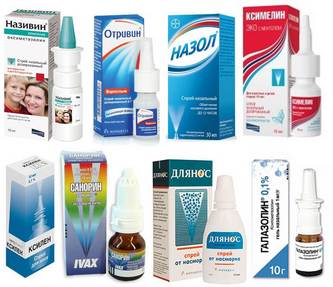 Exceeding the recommended doses can lead to:
Exceeding the recommended doses can lead to:
- increased blood pressure;
- an increase in cardiac contractions;
- the appearance of depression;
- insomnia;
- headache;
- nausea.
Naftizin
The drug quickly causes vasospasm, as a result of which the patency of the nasal passages is restored. After instillation of the nose, a burning sensation, dryness of the nasopharynx may appear.
The drug is not prescribed for pregnant women, during the lactation period, as it has a large number of adverse reactions, including systemic action.
The use of Naphthyzine today is considered irrational, since there are more effective drops with a lower risk of complications.
Sanorin with eucalyptus oil
Due to the presence of eucalyptus oil in the preparation, additional protection of the nasal mucosa from irritating factors is provided, and the process of tissue regeneration is also accelerated.
Medicinal solution is not prescribed until 15 years of age. Among the side reactions, it is worth highlighting:
- burning sensations, dryness in the nasal passages;
- increased congestion;
- change in psycho-emotional state (irritability);
- headache;
- tremor;
- severe malaise;
- nausea;
- increased blood pressure;
- violation of the cardiac rhythm.
Each of the drugs of the group of vasoconstrictors has a certain number of side reactions, contraindications, which limits their use in a child, a pregnant woman and people with severe systemic diseases.
Homeopathic and herbal remedies can be used if desired. You can prepare them yourself or buy a ready-made drug at a pharmacy (Pinosol, Delufen). The process of preparing a medicinal product is a rather difficult and painstaking work with strict adherence to technology and dosage, so it is better to entrust it to professionals.
Nasal drops are used for all children and adults. Among the variety of medicinal drops, you can get lost. The patient does not always buy the drug after consulting a doctor. Most often, the choice of nasal drops depends on the advice of a pharmacist.
To select drops for the intended purpose, you need to know the classification of drugs, composition and method of application.
This group of nasal drops has the least restrictions on use. The moisturizing drops contain a sea water solution. The medicine is intended to moisturize the mucous membrane, eliminate dryness of the nasal passages. Drops are allowed to be used by children, nursing mothers, newborns.
Moisturizing drops can be used daily to cleanse the nasal passages of babies from dry crusts, mucus accumulation. For adults, moisturizing solutions are useful in the following situations:
- In production. People whose profession is associated with chemicals, wood processing, in dusty, stuffy rooms, it is advisable to use nasal drops in the nose to moisturize the nasal passages.
- In unheated rooms. When the office has to work all day with the air conditioner on, the nasal cavity becomes very dry.
- To eliminate the side effects of other drugs. Prolonged use of hormonal and vasoconstrictor drops leads to desiccation of the nasal cavity.
Nasal moisturizing solutions work in combination with other remedies for viral rhinitis. After treatment with a saline solution, the drug penetrates better into the nasal cavity.
Among the moisturizing drops, the most popular are:
- Aquamaris
- Humer
- Saline
- Aqualor
- No-salt
- Physiomer
- Saline
- Marimer
- Neo Maris
- Aqua-Rinosol
- Aqua Max
Such drops do an excellent job with atrophic rhinitis. The majority of drops contain not only sea water, but also trace elements (iron, calcium). The standard dosage is 2 drops in each nasal passage every 3-4 hours.
Saline humidification solutions are available in spray and drip form. Sprays are contraindicated in children under 2 years of age due to the risk of spasm. An overdose of drops is also dangerous: an excessive concentration of salt causes severe swelling of the mucous membrane, so you should not abuse moisturizing solutions either.
Moisturizing drops are more used as an addition to the main drug and as a prophylaxis.
Vasoconstrictor drugs
The largest group of funds. Indications for use: vasoconstriction in the nose to reduce swelling and facilitate nasal breathing. Depending on the active ingredient, all vasoconstrictor nasal drops are subdivided:
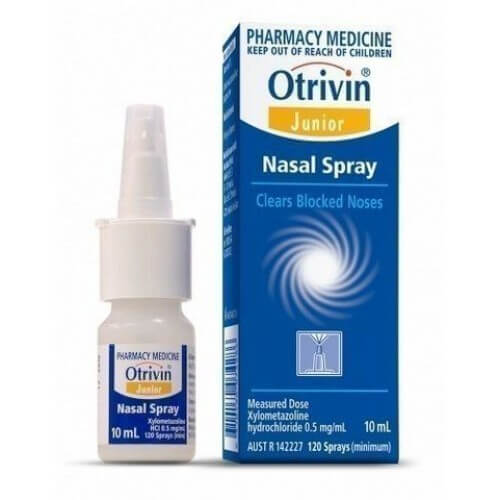
- phenylephrine-based: Nazol Kids and Nazol Baby. Such drops are most often prescribed to children under 2 years old, since they are the safest, have a short effect on the nasal mucous membranes.
- based on naphazoline: Naphtizin, Sanorin. The drug lasts up to 4 hours
- based on xylometazoline: Otrivin, Tizin Xylo, Rinostop, Galazolin, Xilen, Xymelin, Dlyanos. Drops have a therapeutic effect up to 8 hours, are prescribed for children over 6 years old and adults
- based on oxymetazoline: Knoxprey, Rinazolin, Nazol, Nazivin. The effect of the drugs lasts up to 12 hours
Vasoconstrictor drops are intended for symptomatic treatment, they do not kill fungi, viruses or bacteria. Nasal drops perfectly relieve the manifestations of allergies. Drops are prescribed:
- To reduce swelling of the nasopharynx in the treatment of acute middle ear.
- With sinusitis, eustachitis.
- In complex treatment.
The use of such drugs requires compliance with the rules:
- The duration of treatment with vasoconstrictor drops is 7 days in adults, up to 5 days in children.
- It is advisable to bury the nose at night or in the complete absence of nasal breathing during the day.
- Dosage of nasal drops: 2 drops in each nostril no more than 4 times a day.
- For children, vasoconstrictor drops are selected according to age.
Among the side effects of nasal drops are: dryness and itching in the nose, watery eyes,. Caution should be applied vasoconstrictor drugs patients with hypertension and tachycardia.
Frequent use of nasal drops with a vasoconstrictor effect leads to drug dependence and the development of chronic vasomotor rhinitis.
Herbal preparations
Basically, this group of drugs are oil-based nasal drops. Herbal drops are considered a drug because they have anti-inflammatory effects. Essential oil drops are often used in the treatment of children and pregnant women due to their natural composition.
The most popular herbal nasal drops (names):
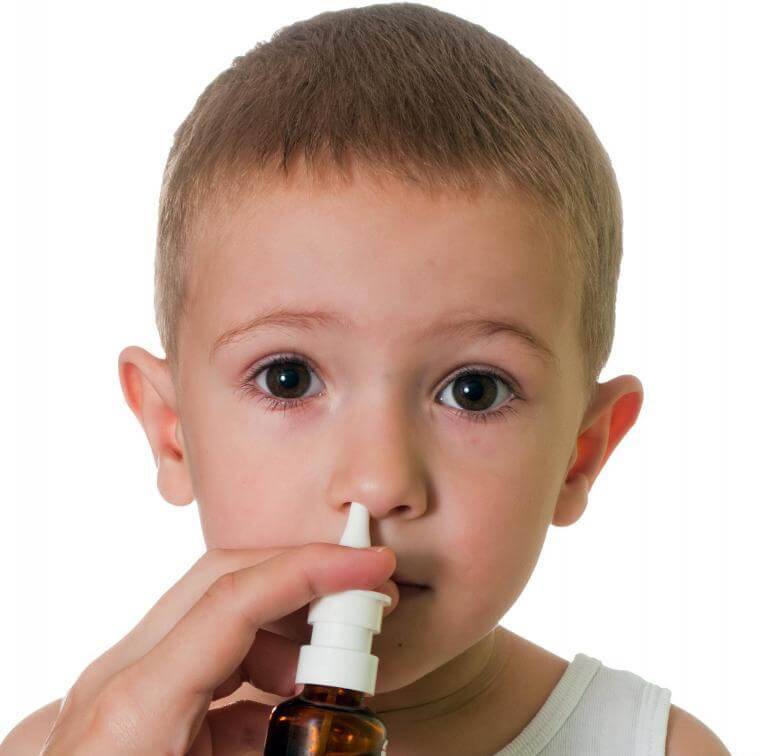
- Pinosol. The undisputed leader among herbal drops. It contains oils of eucalyptus and peppermint, pine, and the substance thymol. Pinosol is approved for the treatment of children over 2 years old, pregnant and lactating with any type of rhinitis. Pinosol has few side effects, it restores the mucous membrane, is not addictive.
- Eucasept. Herbal drops with anti-inflammatory properties, analogue of Pinosol. Contains thymol, azulene, fir, mint and eucalyptus oils. It is prescribed for children after 2 years of age and for adults in the complex treatment of ethmoiditis, adenoiditis, sinusitis.
- Sinusan. Oil-based drops of Japanese mint with antiseptic properties. Improves ventilation of the sinuses, relieves puffiness, stimulates mucus secretion.
- Sinuforte. Designed for the treatment of acute and chronic sinusitis. As part of the product: cyclamen juice. It is produced in the form of a lyophilisate for subsequent preparation of a solution. Forbidden for children under 5 years old and during pregnancy.
- Sinupret. Nasal drops with natural ingredients: sorrel leaves, elderberry, verbena, gentian root, primrose. They are used in the treatment of rhinitis in patients of all ages. It has anti-inflammatory properties.
All oil drops with natural ingredients have: an allergic reaction often occurs to the ingredients of the preparations. Therefore, with a runny nose of an allergic nature, herbal drops are prohibited.
Homeopathic drops
Official medicine is skeptical about the effectiveness of homeopathic remedies. But there are many adherents of homeopathy, so nasal drops can also be found on the shelves of pharmacies.
Among the indisputable benefits of homeopathic drops:
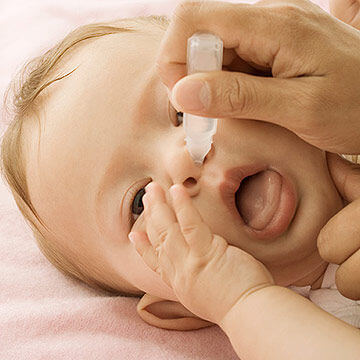
- safety in the treatment of young children
- no side effects
Experienced homeopaths say that in order for the treatment to be effective, each patient needs to be prescribed an individual treatment regimen. The use of such funds is recommended more for preventive purposes. In the treatment of sinusitis, viral or bacterial sinusitis, homeopathic drops will not only not help, but also harm: the infection will spread further.
The drugs are taken strictly according to the scheme, the course of treatment can be from 30 to 120 days. The effect of homeopathy is cumulative. Popular drops:
- Delufen. Recommended for the treatment of chronic atrophic rhinitis, in the complex therapy of allergies, eliminates itching in the nose, moisturizes the mucous membrane.
- Aflubin-Naze. Homeopathic nasal drops for adults. Contains mercury iodide, black mustard extract, meadow lumbago. It is indicated for sinusitis, pharyngitis, hay fever. Allowed for adults and children over 12 years old.
- Edas 131. Contains silver nitrate, extracts of onions and chamomile, sodium chloride. It is often prescribed to children for the prevention of ARVI in the autumn-spring period.
- Euphorbium Compositum. Recommended for the treatment of rhinitis in adults and children. At the onset of the disease, drops are used every 15 minutes for the first two hours.
Before using homeopathic drops, it is advisable to consult with your doctor about traditional medicines.
Antiviral
The overwhelming majority of antiviral drops are made on the basis of interferon: a protein that the body produces during the fight against the virus. Such immunostimulating agents have a therapeutic effect at the very onset of the disease (flu or).
Doctors advise using immunomodulators no more than 2 times a year, so as not to disrupt their own protective function. Antiviral drops are useless in treating bacterial infections.
Most commonly bought drops:
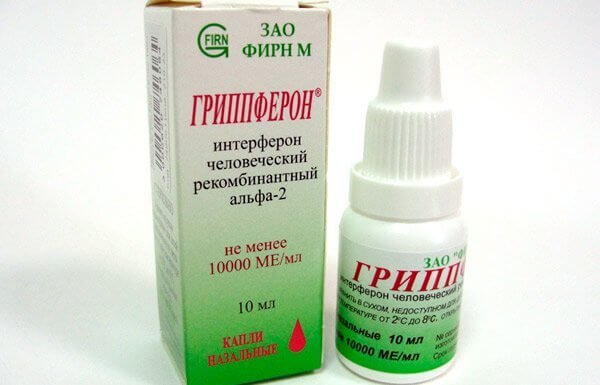
- Grippferon. The drops contain recombinant human interferon. Recommended for treatment and respiratory infections... At an early stage, the dosage of the drug: 3 drops, 4-6 times a day. The duration of therapy is 5 days.
- Ingaron. Contains gamma interferon. It is prepared immediately before use: water is poured into a bottle of powder and shaken thoroughly. Dosage - 3 drops 4 times a day for a week. Ingaron is contraindicated in children under 7 years of age and during pregnancy.
- Derinat. The active ingredient is sodium deoxyribonucleate. Drops are widely used to treat ENT diseases: influenza, sinusitis, tonsillitis, laryngitis,. Derinat should not be used simultaneously with vasoconstrictor and other antiviral drops. Nasal drops are indicated for treatment during pregnancy, in the complex therapy of rhinitis in infants.
- Nazoferon. The main component is synthetic interferon. Recommended for the prevention of seasonal epidemics of influenza and SARS, with hypothermia, for children who often suffer from colds. The age range of patients is unlimited: the drug is approved for use from birth.
Antiviral drops give a therapeutic effect if you start taking it on the first day of the illness.
Antibiotics and antiseptics
The use of antibacterial nasal drops is advisable for a cold lasting longer than 5 days, sinusitis and otitis media. It is better to entrust the choice of a local one to a doctor. Self-medication can lead to disastrous consequences:
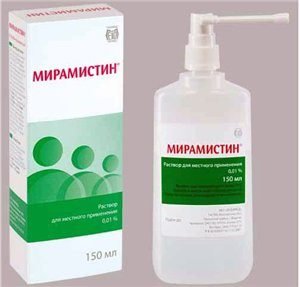
- thinning of small vessels in the nose
- addiction risk
- severe allergic reaction: swelling, burning
- bleeding
Basically, antibacterial drops have a combined composition:
- Polydexa. Allowed for children over 3 years old. The composition includes 2 antibiotics (neomycin and polymyxin), the vasoconstrictor phenylephrine and the antihistamine dexamethasone. Polydexa is prescribed for the treatment of acute sinusitis, since it destroys most pathogenic bacteria.
- Isofra. Contains the antibiotic framycetin. Effective against anaerobic bacteria.
In parallel with the appointment of local antibiotics, it is advisable to sanitize the nasal cavity with antiseptic drops. They are used before instilling an antibiotic to cleanse the nose from purulent discharge or before manipulation by a doctor.
Effective antiseptic nose drops:
- Miramistin
- Dioxidine
- Collargol
- Protargol
- Octenisept
- Albucid
The treatment regimen for each rhinitis is individual. Doctors often combine drugs:
- Polydexa + Pinosol
- Aquamaris + Nazol + Isofra
- Vibrocil + Sanorin
Such treatment is monitored and adjusted by a doctor. The course is usually 7 to 10 days. Nasal drops are instilled at intervals of 40 minutes.
Separately, it is worth highlighting hormonal and antihistamine nasal drops. However, it is better to entrust their choice to the doctor, since for the appointment of such drugs, they must be justified by the patient's diagnosis.
Dec 13, 2016 Violetta the Doctor
Nasal drops are the most common remedy used to treat the common cold (rhinitis).
On the one hand, pharmacology is one of the most advanced branches of medicine. On the other hand, rhinitis is the most common disease in the world. These two circumstances perfectly explain the fact that a huge number of types of nasal drops for children and adults have been created to date.
We buy such drugs very often. But how to independently understand this gigantic ocean of information and make the right choice?
Below we will post for you a list containing the names of the most popular and effective according to doctors' reviews, and their patients, nasal drops for the common cold.
Remember, you should not choose nose drops based on the reviews of friends and Internet portals. If you are concerned about a runny nose, see an otolaryngologist. He will identify the existing type of rhinitis and select the nasal drops that are right for you.
What are nasal drops?
Here is a list of the most commonly used types of drops used intranasally (that is, instilled into the nose):
- vasoconstrictor (adrenomimetics);
- antibiotic (antibacterial);
- antiviral;
- antihistamines;
- moisturizing;
- anti-inflammatory.
Vasoconstrictor drugs
Everyone should know that vasoconstrictor sprays and nasal solutions do not cure a runny nose. They constrict the blood vessels that line the nasal mucosa. Thanks to this mechanism of their action, the edema of the mucous membrane is relieved and free nasal breathing returns for a while.
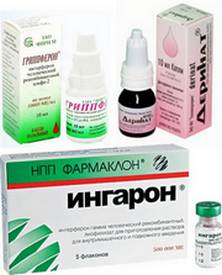
These include:
- Otrivin;
- Nazol;
- Xymelin;
- Xilen;
- Sanorin;
- For the nose;
- Galazolin;
- Vicks;
- and many others.
Adrenomimetics should be taken with extreme caution and in strict accordance with the instructions for use.
Pay special attention to the interval between doses, the maximum duration of uninterrupted use and the recommended dosages. The term for taking such nasal sprays ranges from 3 to 7 days.
Antibiotic drugs
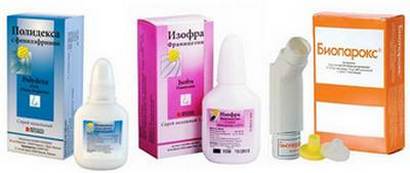
However, it is not entirely correct to call such drugs drops. They come in the form of nasal sprays and aerosols.
The most popular are:
- Polydex;
- Isofra;
- Bioparox.
Antibacterial nasal sprays should only be taken as directed by a doctor. Antibiotics are contraindicated during pregnancy and lactation.
Antiviral drugs
According to statistics, the vast majority of diseases occur due to the defeat of the body by viruses. Antiviral nasal drops are designed to fight these pathogens.

By helping the body defeat this or that virus, they strengthen the immune system. That is why they are often referred to as immunomodulatory drugs.
These include:
- Grippferon;
- Viferon;
- Ingaron;
- and others.
Antihistamines
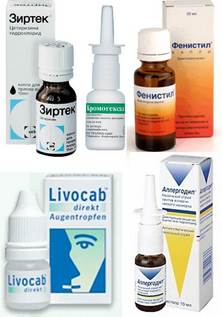
Antihistamine sprays and nasal drops are used to counteract allergic reactions. Since allergies are becoming more widespread these days, such drugs are in ever-increasing demand.
Here are their names:
- Zyrtec;
- Cromohexal;
- Levocabastine;
- Allergodil.
Such nasal sprays should be prescribed exclusively by an allergist-immunologist.
Moisturizers
Moisturizing solutions used for instillation and rinsing of the nose include drugs based on sea water.
Such solutions are extremely effective in cleansing the nasal cavity from mucus accumulating in it and gently moisturizing the nasal mucosa.
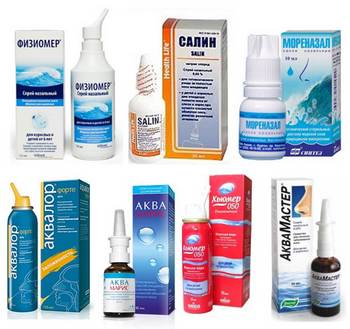
These include:
- Aqua Maris;
- Salin;
- Aqualor;
- Morenazal;
- Physiomer;
- Humer;
- Aquamaster;
- And many others.
Please note that such moisturizing solutions are absolutely safe and can be used to treat all categories of patients. Children, adults, pregnant women, nursing mothers and babies.
However, they don't always have good reviews. Many people are unhappy with them because they expect an instant reaction. This approach is incorrect. Saline solutions based on seawater help reliably, but not very quickly.
Anti-inflammatory drugs
This is a large group of medicines, the main purpose of which is to relieve inflammation of the nasal mucosa.
Among the large number of such drugs, I would like to highlight 2 herbal remedies:
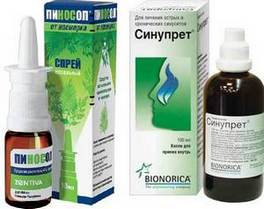
- Pinosol;
- Sinupret.
These are popular medicines that come in many different forms. They are on everyone's lips and generally have positive reviews.
Due to their natural origin, the anti-edema effect they exert on the nasal mucosa is very mild.
Unconventional remedies
Above we have listed the most popular and currently used drugs. However, what drops people do not bury in their nose.
Not quite common or uncommon medications for the common cold include:
- homeopathic;
- mucolytic;
- containing silver;
- eye;
- chinese.
Homeopathic remedies
Homeopathy is a branch of medicine that uses exclusively natural ingredients to create its medicines.
For treatment, such homeopathic drops are used for rhinitis and nasal congestion:
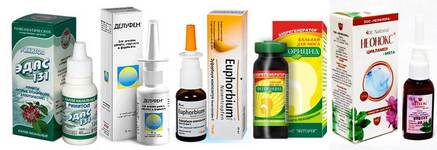
- EDAS-131;
- Delufen;
- Larinol;
- Phytoricide;
- Euphorbium Compositum;
- Neonox Forte.
Mucolytic agents
Mucolytics are designed to liquefy too thick mucous nasal discharge.
Their most prominent representative is Rinofluimucil.
Products containing silver ions
This section should be said about Protargol. Protargol is a colloidal silver solution that has an antiseptic effect on the nasal mucosa.
Protargol has a very short shelf life and is prepared only in specialized pharmacies.
It has a long history of application and great reviews.
Eye remedies
Some people put eye drops into their nose. We want to warn you against such actions. They were called eye for a reason. They are created exclusively for instillation into the eyes.
For your nose, choose from a huge variety of medicines.
The only exception to this rule is the drug. These eye drops are often prescribed by otolaryngologists to their patients. However, you cannot use them without a doctor's prescription.
Drops produced in the Middle Kingdom
At present, quite a few drops have appeared on the Russian market, created in the spaces of our eastern neighbor.
Moreover, there are quite good reviews on them on the Internet. However, we do not recommend using such drugs.
Do not self-medicate. Entrust the choice of the right medicine to your doctor.
For the use of medicines based on oils, certain indications are necessary, since drugs do not always have a positive effect. Oil nasal drops are distinguished by their therapeutic specificity and pricing policy. Often, such solutions are prescribed to moisturize the nasal mucosa after surgery or infectious rhinitis.
Many drugs for intranasal administration, such as vasoconstrictors, can dry out the tissues of the nose. After the end of the treatment course, restoration of the mucous membrane is required, and for this, oil drops are used.
In addition, they can be used for hygiene procedures. Before cleaning the nasal cavities, it is required to lubricate the inner surface of the nose with a small amount of the drug and wait a couple of minutes. During this time, dry crusts soften, which greatly facilitates cleaning and prevents tissue injury.
Application features
Among the disadvantages of oil drops, attention should be paid to:
- an increased risk of an allergic reaction. To avoid a sharp deterioration in the condition, you should study the composition of the drug and use the minimum dose at the beginning of therapy;
- the inability to apply in the first months of life;
- prohibition of use in a nebulizer;
- absence therapeutic effect with allergic rhinitis.
Indications
The most common oil nasal drops have the following names:
- Pinosol;
- Pinovit.
They are appointed:
- to moisturize the nasal mucosa if a person is in adverse environmental conditions for a long time. It can be dry, dusty air in the house or harmful occupational factors (mining, paint and varnish, grain processing industry). With regular use of the medicinal solution, the nasopharyngeal mucosa is protected and becomes less sensitive to irritating environmental factors;
- with atrophic rhinitis. Its development may be due to prolonged use of vasoconstrictor nasal drugs, as well as unfavorable living and working conditions;
- to accelerate the healing of injured tissues in the nasal passages by activating regeneration processes.
Therapeutic composition
The composition of the medicinal product may include:
- peppermint;
- fir, pine extract;
- peach;
- sea \u200b\u200bbuckthorn berries;
- tea tree;
- olive;
- almond.
Due to the specific composition of the drug, it is possible to moisturize the mucosa well, protect it from irritating factors, accelerate tissue repair, slow down the progression of the infectious process and reduce the severity of the inflammatory reaction.
In some cases, the doctor prescribes oil-based vitamins A or E without additional additives.
To obtain the maximum therapeutic effect, it is advisable to follow some recommendations:
- the last nasal instillation should be carried out before bedtime, which allows moisturizing and protecting the nasal mucosa during the night;
- before injecting oil, cleanse the nasal passages of allergens, dust particles and microbes with saline... To do this, you can use solutions based on sea water in the form of aerosols or drops, for example, Aqua Maris, Morenazal, Dolphin;
- keep the humidity in the house at 55%. For this, special devices have been developed - humidifiers. In addition, you can put several containers of water in the room, for example, an aquarium or vases. It is especially important to control humidity during the heating season and when using an air conditioner;
- drink enough liquid per day (2 liters). Of course, the drunk volume should be calculated taking into account concomitant diseases (heart, renal failure), so as not to worsen the person's condition. To replenish fluid losses, you can drink non-carbonated mineral water, unsweetened juice, compote, fruit drink or herbal tea;
- regularly ventilate the room and carry out wet cleaning.
Home treatment with oil drops
Here is a list of ready-to-use oil medicines:
- Pinosol;
- menthol solution. Can be used for hygienic procedures, moisturizing and protecting the nasal mucosa;
- Fish oil-based ectericide. Among the indications, we single out a bacterial infection;
- Equasept. It is prescribed for a viral infection;
- vitamins A, E.
There are many medicines based on peach oil, petroleum jelly and olive oil. Here are some proven recipes:
- 5 ml of vaseline, olive oil should be mixed, add 4 drops of onion or garlic juice. Dripping three drops twice a day. You can also add aloe juice to the mixture of oils;
- 3 g of wild rosemary should be mixed with 15 ml of flax oil. The mixture must be heated in the oven for two hours. It should be instilled drop by drop twice a day.
Pinosol
The composition of the drug includes pine, eucalyptus, mint oil, thymol, as well as tocopherol acetate (otherwise vitamin E). It comes in the form of a nasal drip solution. The liquid has a greenish tint and a menthol aroma.
Pinosol components have antimicrobial, regenerating effect. Among the indications, one should dwell on:
- acute diseases of the nasopharynx, the development of which is based on inflammatory process non-allergic origin;
- postoperative period - to accelerate tissue healing;
- chronic rhinitis, for example, atrophic form.
The drug can also be used for inhalation administration in inflammatory diseases of the respiratory tract.
Contraindications and possible complications
Oil-based nasal drops are not prescribed for hypersensitivity, as well as for an allergic type of rhinitis.
Do not allow the solution to get into the eyes. To avoid a sharp deterioration in the condition and the development of an allergic reaction, it is recommended that you familiarize yourself with the composition of the drops and conduct an allergy test before use.
To do this, it is enough to apply the solution to the back of the wrist and evaluate the test results after 30 minutes. If you experience itching, burning, redness or swelling, Pinosol should be discarded.
The advantage of Pinosol is the possibility of its use during pregnancy, as well as in the lactation period.
The drug has no effect on consciousness, therefore it can be used by people whose profession requires concentration.
Dosage
According to the instructions, the solution can be instilled in three drops every hour (in the first 5 hours of the disease). Then the frequency of use is reduced to three times a day. A child from two years old is prescribed two drops three times a day.
For applications, you need Pinosol and a cotton swab. After applying the oil solution to a cotton swab, you need to insert it into the nasal passage. The duration of the procedure is 15 minutes.
As for side reactions, they are extremely rare. They can be presented:
- an allergic reaction (skin rash, redness, tissue swelling, itching sensations in the nasal passages);
- bronchospasm;
- dryness of the nasopharyngeal mucosa;
- eye irritation;
- contact dermatitis.
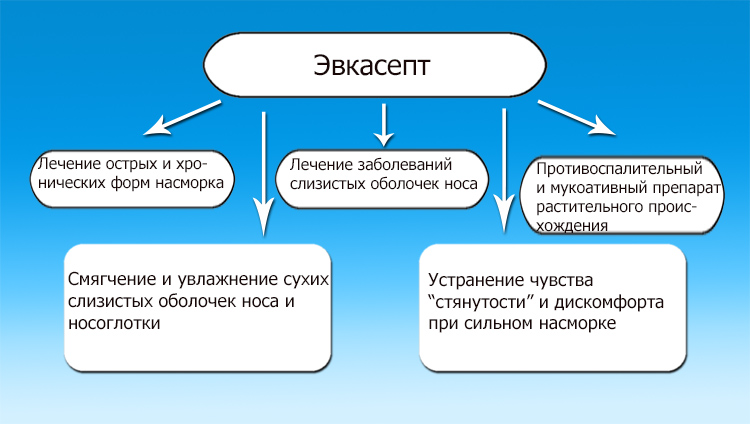 The drug has antiseptic, anti-inflammatory properties. It is prescribed for therapeutic purposes in acute, chronic rhinitis.
The drug has antiseptic, anti-inflammatory properties. It is prescribed for therapeutic purposes in acute, chronic rhinitis.
Eucasept resembles Pinosol in composition. The difference is the presence of azulene in Eucasept, as well as its lower cost. We list the healing effects of the drug:
- pain relief, reduction of tissue swelling - due to peppermint;
- antiviral property due to the presence of fir;
- antiseptic, anti-inflammatory effect is provided by azulene (a component of chamomile essential oil);
- an increase in the antiseptic effect is due to thymol, or otherwise, thyme essential oil;
- antioxidant, protective, regenerating effect - due to vitamin E.
How to use
Eucasept is prescribed exclusively for external use. It can be buried in the nasal passages or applied. It is enough to drip two drops every day four times a day. If the treatment is carried out to a child, it is recommended to drop it three times a day.
For applications, a cotton swab and a medicinal preparation are required. First, it should be applied to cotton wool and inserted into the nasal passage for 15 minutes.
Typically, the therapeutic course is 6 days, however, in agreement with the doctor, it can be extended.
Contraindications and adverse reactions
Quite rarely, cases of adverse reactions after using Eucasept are recorded. Among them it is worth highlighting:
- allergic reactions;
- hyperemia of the mucous membrane;
- itchy sensations in the nasopharynx;
- increased nasal congestion.
Contraindications include:
- age up to two years. A child under the age of two has high risk development of laryngospasm;
- hypersensitivity.
The drug is used with caution in the postoperative period, when surgery was performed in the nasopharyngeal zone. Oil drops have positive reviews from both doctors and patients. All this is due to the mild healing effect and few side effects.
Every mom has had periods in her life when her beloved child started having problems with his nose. This can manifest itself as redness, itching, nasal discharge, sneezing, and coughing. Experts in this field have noticed that babies are most often susceptible to illness - sinusitis! And immediately a lot of questions arise. Which drops to choose? Will not cause allergies? Will they harm a small body? Can I use folk methods? Which one is better? What will remove the problem more effectively?
This article has collected the opinions of various experienced doctors. All doctors advise to choose the right nasal drops, because the course of further treatment and the health of the baby depend on the choice of the drop. First, you need to identify the root of the problem. What kind of disease is it?
Drops in the nose with sinusitis
Drops are very beneficial and most likely the most effective method. Why? First, they quickly penetrate, not only into the body, but also to the inflamed area. Secondly, inflammation is quickly removed. Basically, in a few minutes, you can improve the condition of the nose for the whole day and improve your well-being. Thanks to such effectiveness of drops, you can calmly go about your business all day and forget about problems with your nose.
The most powerful nose drops:
- "Rinostop" Narrows small vessels in the nose, improves mucus permeability. The best drops for the duration of the effect. Can last up to 10 hours.
- "Tizin" Begins to act in a minute.
- "Sinuforte"
- "Nazivin" The most powerful drug, in the opinion of many experts.
All of the above drops are effective. The essence of all of them: to reduce swelling, improve the patency of the nasal ducts, facilitate breathing, and feel comfortable.
Important! Be very careful when choosing a drop if you are suffering chronic diseases, also hypertension or, if there are problems with the thyroid gland. The wrong choice can provoke poor health in these areas.
You need to be especially careful when choosing a treatment for pregnant women. It is important to treat the runny nose when it first appears. Because the viruses found in the mother's body can harm the unborn child. But sometimes it can be common vasomotor rhinitis. But you still need to contact a specialist, because a lack of oxygen can have a negative effect on the baby's body. And this can lead to hypoxia. In turn, hypoxia will lead to irreversible changes in vital organs.
Vasoconstrictor nasal drops:
- "Fornos" Does not irritate the mucous membrane and does not cause hyperemia.
- "Otrivin"
- "Xilen"
- Xymelin
- "Tizin Xylo Bio"
Interesting!These drugs are often prescribed to infants, without harm to health.
But there is also a downside to the coin. Some drops have side effects. It could be headache, and increased blood pressure, and increased heart rate. Therefore, it is very important to consult a doctor to consult which drug will do less harm. As soon as any side effects appear, you need to immediately stop treatment and consult a doctor for help.
In order not to dry out the mucous membranes, it is important to use drops containing oils. They perform three functions at once:
- Anti-inflammatory
- Antibacterial
- Decongestant
The choice of drops with oils also needs to be approached responsibly, because you need to check their compatibility with other stronger drugs.
Important! They shouldn't be addictive.
You may also need antibiotic drops. What for? Because sinusitis can be associated with a virus that has entered the body. And such drops may be simply necessary, because our defense - the immune system simply cannot cope with such strong viruses. There is a misconception that antibiotics should not be taken at all. It is not true! Sometimes health depends on their use, and sometimes life. The concentration in antibiotics is not so small that it does not harm the body in any way.
Doctors advise! The choice of antibiotic drops is very responsible! But it is better to use it only in cases where the runny nose does not go away for more than 5 days or in case of complications.
Good antibiotic nasal drops:
- "Polydexa"
- "Isofra"
- "Vibrocil"
Important! Long-term use of antibiotic drops can develop into severe allergies. To prevent this, it is imperative to follow the prescription and instructions of the doctor. In no case should the dose be exceeded and the period of treatment should not be increased.
Few people now suffer from allergies. Although it will completely get rid of it, it is possible only in rare cases, it is possible to reduce the manifestations. Now there are many drops from allergies. Which ones will be more effective?
Treating nose drops:
- "Allergodil"
- Derinat
- "Amavis"
- Fluticasone
- "Naphtizin"
Be careful! "Naphthyzine dependence" may occur. It is very dangerous. After all, then a person cannot live without these drops. It will not drip - the head, nose, ears will hurt. Therefore, it is advisable to use these drops specifically for only 5 days.
The doctor says! Dr. Komarovsky advises to resort to traditional medicine. One of the most best drops with a virus: the well-known chamomile with honey. And immediately the questions: how should it be brewed? How many drops to bury?
So, first you need to make an infusion of chamomile. You can buy it at the pharmacy or dry it yourself. For one tablespoon, one glass of boiling water. Fill and leave for 20 minutes, filter and cool over time. Add a spoonful of honey to it.
Dripping one or two drops several times a day. Why is the decoction so effective? Chamomile is anti-inflammatory and honey is antiseptic. Together, they can relieve inflammation and speed up recovery. Correctly using traditional medicine, you can not only be cured without using serious medications, but also significantly save your family budget.
Another type of drops: sea water solutions. They are good at helping to remove thickened mucus, disinfect and dry out the mucous membrane. The advantage of this treatment: there are no contraindications. They can be dripped as much as needed.
Important! Remember, although the drops have no contraindications, they are distinguished into adults and children. Added more in drops for adults sea \u200b\u200bsalt... And such a solution, instead of helping, will harm a small nose.
Good nasal drops for adults:
- "Grippferon"
- "Pinosol"
- "Rinonorm"
Advice! It is important to consult your doctor before using any method. Never use an unfamiliar drug on your own, as it can lead to various side effects.
How to bury drops correctly (video)?
Harm of nasal drops (video)
